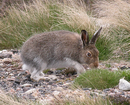Showing Food Mountain hare
| General Information | |||||||||||
|---|---|---|---|---|---|---|---|---|---|---|---|
| Name | Mountain hare | ||||||||||
| Scientific Name | Lepus timidus | ||||||||||
| Description | "The mountain hare (Lepus timidus), also known as blue hare, tundra hare, variable hare, white hare, snow hare, alpine hare and Irish hare, is a hare that is largely adapted to polar and mountainous habitats. The mountain hare is a large species, though it is slightly smaller than the European hare. It grows to a length of 45?65 cm (18?26 in), with a tail of 4?8 cm (1.6?3.1 in), and a mass of 2?5.3 kg (4.4?11.7 lb), females being slightly heavier than males. In summer, for all populations of mountain hares, the coat is various shades of brown. In preparation for winter most populations moult into a white (or largely white) pelage. The tail remains completely white all year round, distinguishing the mountain hare from the European hare (Lepus europaeus), which has a black upper side to the tail. The subspecies Lepus timidus hibernicus (the Irish mountain hare) stays brown all year and individuals rarely develop a white coat. The Irish variety may also have a dark/grey upper surface to the tail, which in other populations always remains white. This tail colour combined with its large size (in comparison to most other populations of mountain hare) and the various shades of brown that the Irish hare may display, could lead an unexperienced observer to misidentify an Irish mountain hare as a European hare." | ||||||||||
| Primary ID | FOOD00581 | ||||||||||
| Picture |  | ||||||||||
| Classification | |||||||||||
| Group | Animal foods | ||||||||||
| Sub-Group | Lagomorphs | ||||||||||
| Taxonomy | |||||||||||
| Superkingdom | Eukaryota | ||||||||||
| Kingdom | Metazoa | ||||||||||
| Phylum | Chordata | ||||||||||
| Class | Mammalia | ||||||||||
| Order | Lagomorpha | ||||||||||
| Family | Leporidae | ||||||||||
| Genus | Lepus | ||||||||||
| Species | timidus | ||||||||||
| Variety | Not Available | ||||||||||
| External Links | |||||||||||
| ITIS ID | 180113 | ||||||||||
| Wikipedia ID | Mountain_hare | ||||||||||
| Composition | |||||||||||
| Compounds |
Processing... | ||||||||||
| Macronutrients |
Processing... | ||||||||||
| References | |||||||||||
| Content Reference | — Saxholt, E., et al. 'Danish food composition databank, revision 7.' Department of Nutrition, National Food Institute, Technical University of Denmark (2008). | ||||||||||